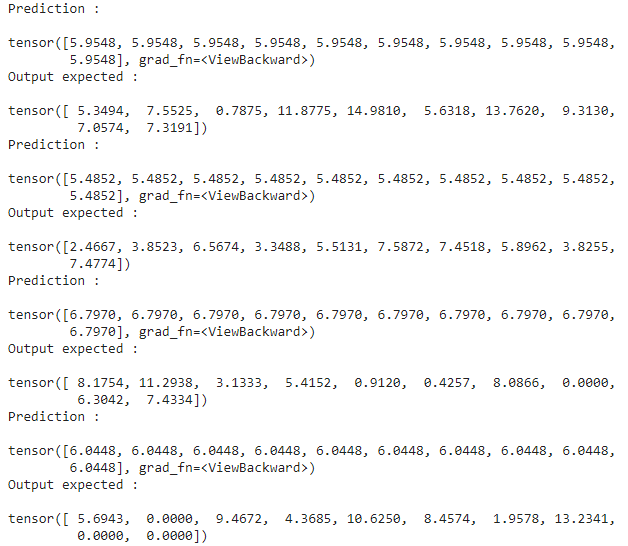Hello,
I am a beginner with PyTorch, and I’m working on a small project which consists in predicting some output. To do this I’m using a Neural Network that has a few layers with simple transforms.
When I try to run my code I’m faced with the following problem : every prediction of my neural network is 0 (sometimes it gives other values in the first batch when I’m lucky enough…)
Here is the code of my project :
import torch
from torch import nn
from torch.utils.data import DataLoader
from torch.utils.data import Dataset
from torchvision.transforms import Lambda, Compose
import matplotlib.pyplot as plt
import numpy as np
n = 20 #Nombre de variables de direction résumant la variance du payoff
d = 20 #Dimension de l'option
N_data_training = 5000 #Taille de la base de donnée utile à l'apprentissage du réseau de neurones
N_data_test = 2500 #Taille de la base de donnée utile au test de la précision du réseau de neurones entrainé
type_product = "basket call" #Type de produit dérivé
S0 = 100 #Spot price
K = 100 #Strike
T = 1 #Maturité
r = 0.05 #Taux d'intérêt sans risque
sigma = 0.2 #Volatilité
# Nmc = 1000 #Nombre de trajectoires générées pour l'estimation de Monte-Carlo
learning_rate = 1e-3
device = "cuda" if torch.cuda.is_available() else "cpu"
print("Using {} device".format(device))
def payoff_derivative(N_data, type_product, d, S0, r, sigma, T): #### pay-offs test
payoff = np.zeros(N_data)
Z = np.zeros((N_data, d))
if type_product == "basket call":
for i in range(N_data):
Z[i, :] = S0*np.exp((r-0.5*sigma**2)*T + sigma*np.sqrt(T)*np.random.randn(d))
payoff[i] = np.maximum((1/d)*np.sum(Z[i, :], axis=0) - K, 0)
return (Z, payoff)
pure_data_training = payoff_derivative(N_data_training, type_product, d, S0, r, sigma, T) ##### pay-offs pour l'apprentissage du réseau de neurones
pure_data_test = payoff_derivative(N_data_test, type_product, d, S0, r, sigma, T) ##### pay-offs pour le test de précision
class Creation_Dataset(Dataset):
def __init__(self, pure_data):
self.Z = pure_data[0]
self.payoff = pure_data[1]
def __len__(self):
return len(self.payoff)
def __getitem__(self, idx):
return torch.tensor(self.Z[idx],dtype=torch.float), torch.tensor(self.payoff[idx],dtype=torch.float)
dataset_training = Creation_Dataset(pure_data_training)
dataset_test = Creation_Dataset(pure_data_test)
# Creation des data loaders
batch_size = 100
train_dataloader = DataLoader(dataset_training, batch_size)
test_dataloader = DataLoader(dataset_test, batch_size)
for X, y in train_dataloader:
print("Shape of X : ", X.shape, X.dtype)
print("Shape of y: ", y.shape, y.dtype)
print(X[0])
print(y[0])
break
class NeuralNetwork(nn.Module):
def __init__(self): ######méthode dans laquelle on définit les couches du réseau
super(NeuralNetwork, self).__init__()
self.flatten = nn.Flatten() ########## convertit en tenseur 1D
self.linear_relu_stack = nn.Sequential(
nn.Linear(d, n, bias=False),
nn.Linear(n, 6),
nn.ReLU(),
nn.Linear(6, 15),
nn.ReLU(),
nn.Linear(15, 10),
nn.ReLU(),
nn.Linear(10, 5),
nn.ReLU(),
nn.Linear(5, 1),
nn.ReLU()
)
def forward(self, x):
logits = self.linear_relu_stack(x)
return torch.reshape(logits, (-1,))
model = NeuralNetwork().to(device)
print(model)
loss_fn = nn.MSELoss(reduction='sum')
optimizer = torch.optim.SGD(model.parameters(), lr=1e-3)
def train_loop(dataloader, model, loss_fn, optimizer):
size = len(dataloader.dataset)
for batch, (X, y) in enumerate(dataloader):
# Compute prediction and loss
print("Shape of X : ", X.shape, X.dtype)
print("Shape of y: ", y.shape, y.dtype)
pred = model(X)
print(pred)
loss = loss_fn(pred, y)
# Backpropagation
optimizer.zero_grad()
loss.backward()
optimizer.step()
if batch % 100 == 0:
loss, current = loss.item(), batch * len(X)
print(f"loss: {loss:>7f} [{current:>5d}/{size:>5d}]")
def test(dataloader, model):
model.eval()
test_loss, correct = 0, 0
with torch.no_grad():
for X, y in dataloader:
X, y = X.to(device), y.to(device)
pred = model(X)
test_loss += loss_fn(pred, y).item()
correct += float((pred == y).sum())
size = len(dataloader.dataset)
test_loss /= size
correct /= size
print(f"Accuracy: {100*correct:.2f}%, Avg loss (sqrt(MSE)) : {np.sqrt(test_loss):.3f} \n")
epochs = 2
for t in range(epochs):
print(f"Epoch {t+1}\n-------------------------------")
train(train_dataloader, model, loss_fn, optimizer)
test(test_dataloader, model)
So, using a DataLoader that creates batches of batch_size, I train my Neural Network in the train_loop() function and I print out my predictions’ tensor, and it turns out that all my predictions are zeros. I’ve seen a few topics with people facing this kind of problems with classification problems, but I’m still trying to solve it for predicting correct outputs.
Thank you for your time
